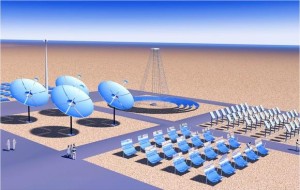Solar power generation Researchers' keyword commentaries

Sunlight is the most abundant natural energy source. Indeed the Sun provides the source for all forms of energy (except for nuclear power): fossil fuels were created by sunlight in the past, and wind power, wave power, and biomass also represent energy created by sunlight of today. The total amount of energy delivered by the Sun is equivalent to the energy provided by about 50 million nuclear reactors. If we can harness that energy efficiently, we will never be short of energy.

Illustration of solar power generation in the desert, the theme of GS+I project.
© Global Solar+ Initiative.
Solar power generation is a technology that generates electrical power directly from sunlight, while solar thermal power generation is a similar but different technology that converts sunlight into thermal energy to generate electricity indirectly using turbines and by other conventional means. In solar power generation, solar cells play a core role in converting light energy directly into electrical energy. The biggest problem related to this method of power generation is variations in the amount of power generated, which depend on the weather and the length of the day and night. When such an unstable power source is connected to the current power system, other power generators need to operate in a pattern that compensates for the instability. This can severely affect the stability and efficiency of the entire system. This is the main reason why solar power generation has not been fully introduced. In Japan and other regions where the weather is not always clear, the operating rate of solar power generation systems would be low, which would in turn raise operating costs, making it difficult to introduce these systems on a large scale.
Before fully introducing solar power generation as a new energy source, it is essential to improve the conversion efficiency of solar cells, secure backup power sources, and develop large secondary batteries for short-term storage, as well as to develop technologies that can store solar energy temporarily or for a long period of time on a medium- to long-term basis. It is also necessary to further foster the introduction and spread of solar power generation in low-latitude desert areas where solar energy can be obtained at the lowest cost. To this end, the University of Tokyo has been commissioned by the New Energy and Industrial Technology Development Organization (NEDO) to research and develop innovative solar power generation technologies. Accordingly, the University has been conducting research and development on highly efficient next-generation solar cells, while launching a project to establish a sustainable global energy system based on the use of solar energy (“Endowed Chair for Global Solar+ Initiative”: GS+I) toward the large-scale introduction of solar power generation under international cooperation.
Professor Yoshiaki Nakano
Global Solar Initiative (Endowed Chair)
Nakano, Sugiyama and Tanemura Laboratory
Research Center for Advanced Science and Technology
(This article first appeared in the tenth issue of Tansei.)






